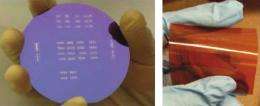December 6, 2011 feature
Printed CNT transistor circuits may lead to cheaper OLED displays

(�鶹��ԺOrg.com) -- While flexible OLED displays have begun appearing in some cell phones, the technology is still too expensive to be widely used in consumer electronics. In one of the latest attempts to enable low-cost mass-production of OLED displays, researchers have fabricated the first complete thin-film transistor circuits printed with a carbon nanotube (CNT) solution for use with display electronics. They found that these circuits are not only easy to fabricate, but they also work as excellent current switches when connected to OLEDs.
The printed transistor circuits were developed by a team of researchers at the University of California at Los Angeles (UCLA); Aneeve Nanotechnologies, a start-up company at UCLA; and the University of Southern California, Los Angeles. Their work is published in a recent issue of Nano Letters.
Although other groups have printed CNT transistors, this is the first time that researchers have successfully printed the complete transistor circuitry: not just the CNTs, but also the metals, polymers, and all other components. In doing so, the work demonstrates for the first time that a fully printed CNT process can be used to fabricate a complete circuit.
Fully printed CNT transistors satisfy two key issues for mass-producing OLED displays at a low cost: they use an inexpensive, fast, and simple process (ink-jet printing), and they use materials with favorable electrical characteristics (CNTs).
“CNTs are more stable compared to other organic semiconductor materials,” coauthor Kosmas Galatsis from Aneeve Nanotechnologies and UCLA told �鶹��ԺOrg.com. “They have superior electronic properties and transistor performance.”
To print back-gated thin-film transistors, the researchers used a commercial silver nanoparticle solution to print the source and drain electrodes. Using a recipe for a semiconductive single-walled CNT (SWCNT) solution that they previously developed, they printed the channel. Tests showed that these printed SWCNT transistors show a similar performance to that of SWCNT transistors fabricated with more expensive photolithographic techniques.
In the second part of their study, the researchers connected two printed SWCNT transistors to an OLED and used them to switch the OLED on and off. The transistor’s good current carrying capacity and other electrical characteristics allow for a dense integration of pixels and low power consumption, making it an ideal component for OLED display backplanes.
By adding a layer of polyethylenimine with LiClO4 to the top of the CNTs on the back-gated SWCNT transistor, the researchers could fabricate a top-gated transistor. Then they printed this transistor on flexible Kapton material, demonstrating the potential of using it for flexible electronics.
As the first demonstration of printing a SWCNT solution to make complete transistor circuits for OLED displays, the results of the study suggest that carbon nanotube-based electronics could provide a way to bring OLED displays closer to mass commercialization.
“Our plans are to continue to develop this process for scalability and manufacturing,” Galatsis said. “We plan to be printing products in two years. Commercialization will need to take place with a larger manufacturing partner.”
More information: Pochiang Chen, et al. “Fully printed Separated Carbon Nanotube Thin Film Transistor Circuits and Its Application in Organic Light Emitting Diode Control.” Nano Letters.
Journal information: Nano Letters
Copyright 2011 �鶹��ԺOrg.com.
All rights reserved. This material may not be published, broadcast, rewritten or redistributed in whole or part without the express written permission of �鶹��ԺOrg.com.
















